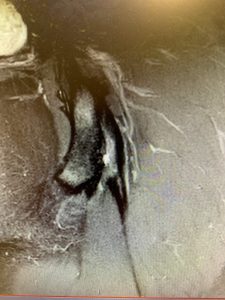Hamstring syndrome – when operative treatment?
Lasse Lempainen
Orthopaedic surgeon
Hospital Mehiläinen NEO, Turku, Finland
Introduction, symptoms and clinical findings
Proximal hamstring tendinopathy, also reported under the name of hamstring syndrome, is an overuse injury which expresses itself by lower gluteal pain especially during sports and running with a faster pace. It has been seen in athletes of various sports activities but especially in sprinters and middle- and long-distance runners.
Most of the hamstring syndrome patients suffer also from pain at the site of the ischial tuberosity while sitting for a prolonged time. Often the pain has appeared and increased gradually without any acute event. However, sometimes the initial onset of pain has been after sudden mild injury to the posterior thigh (muscle strain or over stretching). In both ways continued exercises and stretching of the posterior thigh have made the situation gradually worse.
On clinical examination active stretching of the hamstring muscles results often in pain at the site of the ischial tuberosity. Commonly no remarkable weakness in knee flexion or in hip extension is noted in manual tests. Hip extension without load or resistance and knee flexion against resistance are often painful. No abnormalities are normally found in neurological tests such as Lasegues' sign and reflex testing.
Diagnosis
The pre-operative diagnosis is based on history, clinical examination, and diagnostic imaging. MRI is sensitive in detecting hamstring tendinopathy (Fig 1-3). The findings of hamstring tendinopathy on MR images are: increased signal intensity on T1- and T2-weighted images, thickening of the tendons, peritendinous edema and bone marrow edema like changes in the ischial tuberosity. Peritendinous edema with a distal feathery pattern is more reliable sign of tendinopathy. Sometimes clear scar tissue / adhesions around the sciatic nerve can also be seen.
Treatment
Hamstring syndrome / tendinopathy is not uncommon condition among athletes. It is often debilitating problem and can be very difficult to treat. The ideal treatment method for hamstring tendinopathy is still unclear. What we know for sure is that active (long) stretching worsens the gluteal area pain. Corticosteroids can provide temporary pain relief but they do not appear to have any long-term benefit. PRP injections do not help in chronic cases and they often cause more scar and adhesions and thus increase tightness of the posterior thigh. In chronic phase proximal hamstring tendinopathy seems to be quite resistant to conservative treatment.
Surgery remains a last alternative for the treatment of chronic hamstring syndrome. Often it is a valuable option and it yields highly successful return to sports in most cases. However, sometimes surgery has been delayed for too long time and the optimal time for surgical treatment can be over.
You can read more about surgery, surgical technique and results in following studies:
Figures 1-3.
Typical mri findings in hamstring syndrome.
- Figure 1
- Figure 2
- Figure 3






